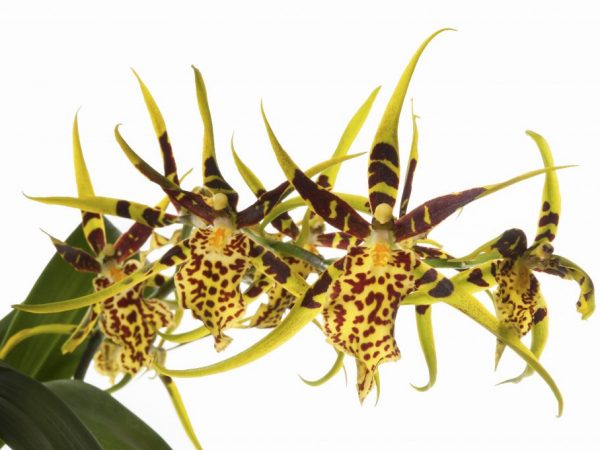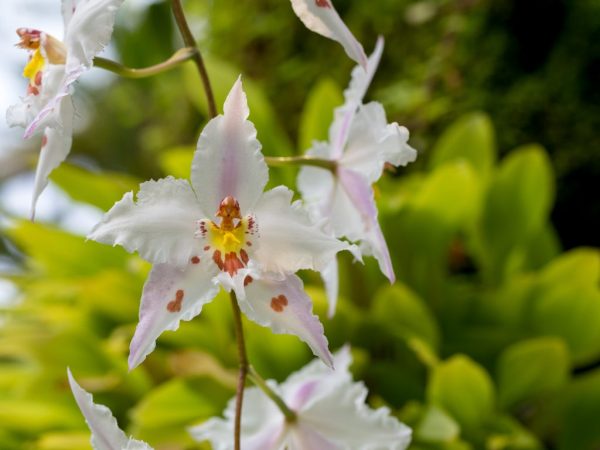Growing Brassia Orchids
Orchid Brassia belongs to the epiphytic plants of the Orchid family. It is distinguished by an unusual type of flowers with elongated sepals. For this culture is called "spider orchid". In the wild, it grows in the humid forests of the American tropics. It is also successfully grown at home. The plant has 34 natural species and 33 artificially bred.

Growing Brassia Orchids
Characteristics of the variety
The orchid was named after the botanist V. Brass. It is a flowering perennial plant, in the middle of which pear-shaped pseudobulbs are formed. After the end of development, they die off, new ones appear in their place. The creeping stem of Brassia is short, so the bulbs are located close to each other, sometimes touching. At the top of each are several oblong-lanceolate leaves. They are deep green, dense, articulated, fan-shaped. The surface is smooth.
The inflorescence is unbranched, develops in the leaf axils. Peduncle 15-20 cm long, up to 15 successive buds are formed on it. The flowers have narrowed sepals, the length of which reaches 15 cm. Their edges are thin. Petals are short, sometimes crossed. The shape is more rounded. The lip is large, not attached to the column. The color of the flowers is different: white, lemon, purple or brown. The surface is spotty. The aroma is intense, reminiscent of the smell of daffodils.
The most popular species of this genus are:
- Brassia Warty (Red);
- Brassia Summer Dream (Tinto);
- Tuscany;
- Mystic Maze-muse;
- Brassia Spotted;
- Brassia Tailed;
- Brassidium;
- Royal.
Growing
The process includes many stages. In order for the plant to grow and develop correctly, it is provided with all the necessary conditions.
Landing
The culture is propagated by seeds and dividing the bush. To do this, take a small transparent plastic pot. Holes are made in the bottom to leave excess moisture. Pieces of foam are placed on the bottom. Above - a layer of bark in fractions of 2.5-3 cm. It is harvested in advance, cut. Pebbles and wood are also taken as drainage.
The substrate is used commercially, especially for orchids. It is also prepared with one's own hand. To do this, take:
- 40% pine bark;
- 25% sphagnum moss;
- 25% charcoal;
- 10% dry leaves.
Seeds
Seeds are prepared before planting: first, they are disinfected. For this purpose, prepare a solution of 15 g of lime per 100 ml of water. It is filtered, after which the grains are placed inside for 10 minutes. The liquid is stirred periodically.
At home, Knudson's medium is used for germinating seeds, which is prepared according to the instructions. Its acidity should ideally be 4.8-5.2 pH. The solution is poured into sterilized vessels to a level of 1.5-2 cm, closed with a stopper and sterilized again. A pressure cooker is great for this. It is also used for sowing seeds: then spores and bacteria do not enter the container.
A vessel is placed in boiling water. The seeds are transferred using a sterile tube. For uniform distribution of the seed, the solution is shaken. The container is closed.All actions are performed quickly.
The jars are placed in an environment with a temperature of 18-22 ° C. Crops are provided with diffused light for 12 hours. Over time, leaves appear on the surface of the liquid, then roots grow. After a year, the sprouts are planted in a prepared steamed substrate. To do this, they are carefully removed from the jar, washed under running water.

The cultivation process is long
By dividing the bush
Less time consuming process. For planting in spring, the plant is divided into parts. Each of them should contain 2-3 bulbs with healthy white roots. Spoiled and soft ones are removed. The rest are immersed in warm water so that they straighten and cleanse. They are planted in a substrate, placed on a windowsill on the east side. During the week, only spraying is performed, but make sure that water does not get into the center of the outlet.
Care
When growing Brassia at home, it is provided with good illumination for 12-13 hours a day. In winter, the plants are illuminated. Direct sunlight should not fall on the flower. The optimum temperature for proper development should be at the level of 20-25 ° C during the day and 17-18 ° C at night. The culture does not accept dry air, so it is regularly sprayed. Also does not tolerate drafts.
Watering is done in this way: a pot for 15-30 minutes. immersed in a container with warm, settled water. During this period, the plant will be saturated with moisture. Wrinkles on the bulbs indicate excessive moisture. In this case, watering is stopped for 7 days.
In winter, a dormant period begins for the orchid. To do this, it is placed in an environment with a temperature of 3-5 ° C for 2-3 weeks. The frequency of watering at this time is reduced. Also in May and September, the pot is placed on an unheated balcony.
Crop care includes a transplant, which is performed every 2 years. It is not worth performing the procedure once again. To extract the plants, press or knock on the pot. Then they pay attention to the roots:
- separate them from the old soil by hand, wash;
- dry and damaged parts are cut off with sterile scissors or a knife, capturing the healthy part;
- the places of the cuts are treated with sulfur or charcoal;
- allow to dry for several hours.
The pot is taken 4 cm larger in diameter compared to the previous one. It is washed with soapy water and boiled. The plant is planted in the center, without deepening too much, otherwise the sprouts will rot. The transplanted Brassia is placed under a warm shower (36 ° C). The next watering is done in 2-3 days. After transplanting, the plants are shaded, they are provided with high air humidity. For this purpose, you can place the pot near the aquarium.
Top dressing is done approximately every 10 days with a special fertilizer for orchids. They are used according to the following principle:
- from spring to summer, substances containing more nitrogen are introduced;
- from mid-summer to autumn - with a high content of potassium and phosphorus.
This ensures constant flowering and good vegetative development of the orchid. In winter, feeding is stopped.
Diseases and pests
Fight disease
The main disease from which the culture suffers is rotting of the bulbs and roots. Because of this, the leaves turn yellow, the plant dies. The development of the disease is able to provoke an excess of water and low temperature, therefore, watering is stopped, the correct temperature regime is set.
Pest control
Brassia is often affected by spider mites. To combat it, the orchid is placed under a hot shower (45 ° C). Infection with scabbard and mealyworms from other indoor plants also occurs. All pests are fought with the help of the preparations "Karbofos", "Fozalon", "Actellik".
Prophylaxis
To prevent the development of disease, crops are provided with proper care and optimal growing conditions. It is important to prevent stagnation of water in the soil, therefore, drainage must be laid when planting. The holes are periodically cleaned. The substrate is disinfected.
Conclusion
The genus of orchids Brassia amazes with a variety of species.Brassia Warty is suitable for beginners for growing. She is the least moody of all types. The plant feels good at home, blooms almost all year round.


